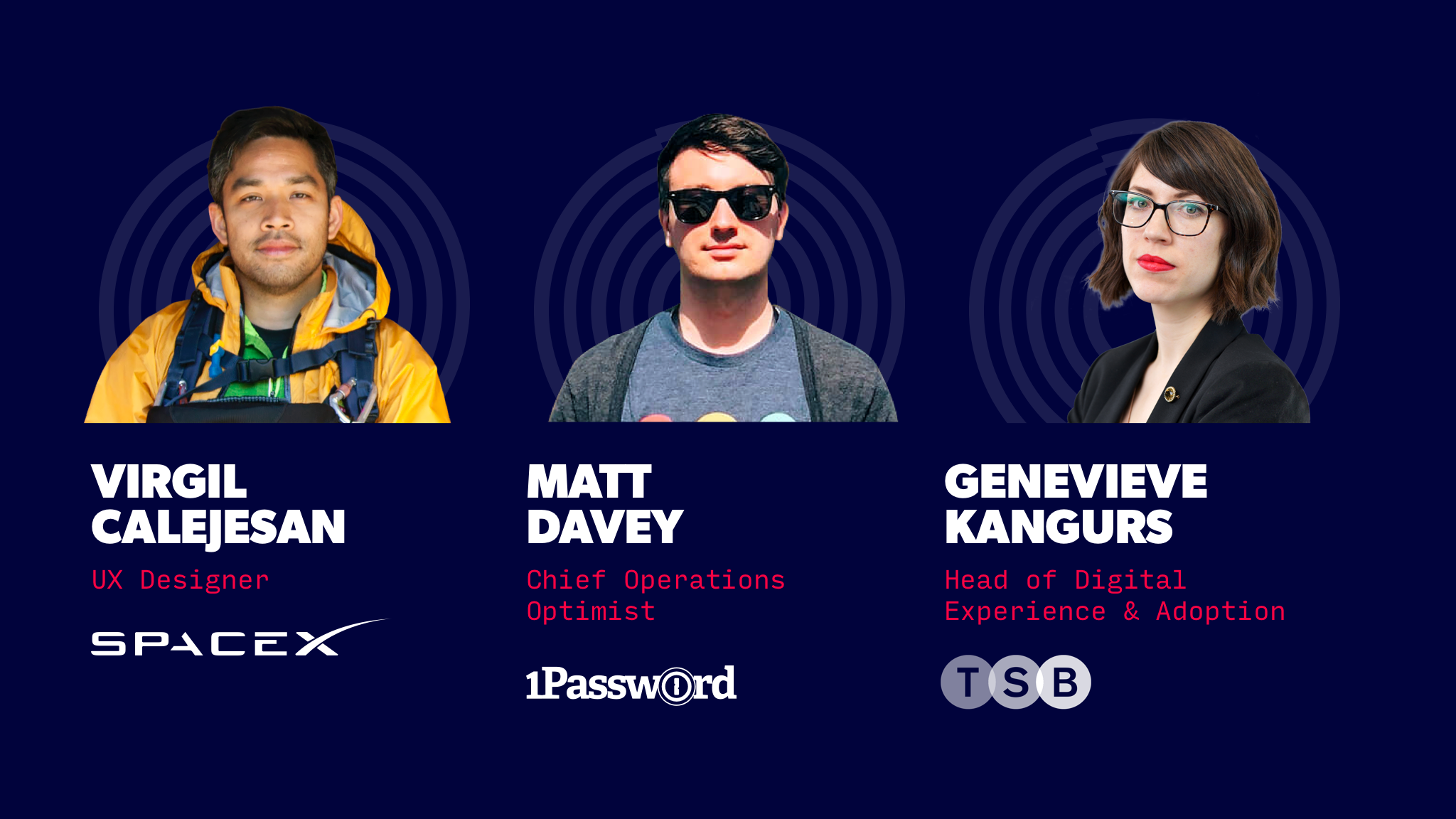Meet the Speaker: Virgil Calejesan from SpaceX
Over the last few weeks, I’ve been lucky enough to chat to this year’s Canvas speakers, as well as some of our alumni, to ask about their career journeys, their secret weapons, and the product mindset.
This week, I’m introducing you to Virgil Calejesan, a UX Designer at SpaceX, based in California. We chat over Google Meet and I do the very British thing of asking about the weather – it’s reliably raining in the centre of Birmingham, and we agree that it’s nice to have something that’s predictable at this point, at least…! We discuss how Virgil tackles all things UX, research and design, and the realities of working alongside literal rocket scientists.

Stephanie //
Tell me a bit about your role. What do you do and who do you do it for?
Virgil //
Sure. I’m a UX researcher and software designer at SpaceX. So, nothing too crazy – typical role! I work a lot with users. Any part of my day, I’m switching between speaking with those users, putting together features, functions, needs, and use cases, based on these users, and then translating those into visuals of some kind – workflows, wireframes, and eventually final drawings for software.
I ended up in this role kind of by accident. I’m in LA now – I was originally living in New York. I was forwarded a job listing that was for a four week contract, and I was meant to do a heavy amount of research to feed a team for many projects downstream. About two weeks in, my manager asked me if I’d be interested in making this a full time play. That was a very, you know, wide-eyed, ‘oh my god!‘ moment, and we went down that route, and I’m still here today.
Stephanie //
What’s the best thing about what you do at the minute? What gets you up in the morning, excited to go to work for the day?
Virgil //
I think this speaks largely of me, but it’s a variety of things. I’m in a very large company. We have a factory that consists of 20 plus buildings that are appended to our office space, and we have a variety of sites across the country. So, when I work with users, those users span a broad spectrum of people. My consumers are engineers – literal rocket scientists! We have groups focusing on production, quality control, mission, and launch. We have our administrators, of course, our HR department, we have our finance groups, but we also have technicians who are “turning wrenches” in the most technical way. It’s just an interesting variety of people we work for, and our software reflects that. We build a lot of internal software ourselves, and you can imagine that enterprise suite of software – it’s well into the teens and dozens in terms of variety. So for me, it’s very interesting because I do my work, design and research, but within a very, very broad space, which I think keeps things incredibly engaging and challenging. That’s a great mix.
Stephanie //
Is it ever daunting to know that you’re working with people like rocket scientists, people who are obviously at the top of their game, and you’ve got to design something that’s going to keep up with where their minds are?
Virgil //
Absolutely. Absolutely. I think that has a lot to do with respecting the craft. I actually think anyone’s needs should be, in a way, daunting. You’re trying to solve someone else’s problems in a way that satisfies them. But I also think it’s incredibly motivating. There’s a huge aspect of trust that goes into it, that adds to that feeling of ‘daunt’. At the same time, you know what you know, in your area – they know what they know, in their area.
I feel, from a person to person basis, it’s just a matter of two people with expertise coming together trying to solve a problem. Maybe that’s how I get through my day to day, is to say, ‘Alright, this is just humans solving problems.’
"I think anyone's needs should be, in a way, daunting. You're trying to solve someone else's problems in a way that satisfies them."
Stephanie //
That’s a good way to look at it. On the flip side, what’s the worst thing about what you do? What keeps you up at night or stresses you out? What’s the bit that you don’t enjoy?
Virgil //
Honestly, the job is so wonderful. I really can’t complain! I think everyone has that perfectionist twist in them, and we move very quickly. I think it’s that balance between wanting to be perfect but also wanting to move quickly and be effective, still, at speed. There’s a phrase they use a lot here and it touches a lot of what I think about, which is, ‘build a little, learn a lot.’ Where do you slot in this desire for perfection?
Normally it takes time, normally you go slowly, and you want to learn not just a lot, you want to learn everything. You just can’t do that at the pace we’re looking for. That makes it tough, because you have this internal tension between deliverables and deadlines and the desire for improving, improving, improving. You just have to constantly fight that, keeping the larger goals in mind.
Stephanie //
When it comes to techniques or processes, is there a secret weapon that you couldn’t work without? What’s in your toolbox?
Virgil //
Oh.. a big smile!
I joke, but I actually think that in my particular toolbox that has come into great use is. What I mean by that is skill with people, if I was to translate it into a job skill.
That’s the part that interests me the most – the human aspect, the insight, the connection, the relationship building. That’s where I draw a lot of my personal motivation and reward from the work.
If you’re looking to design at speed, then you need to also find insight at speed, which to me implies making connections quickly. Having rapport and respect is really important, but so is being sincere. That human aspect of design is something I love and something I nurture, and I think I’m lucky enough to have a certain amount of talent with.

Stephanie //
What would you say is the most important lesson you’ve learned so far?
Virgil //
I hate to sound trite but humility has been the biggest lesson. There’s the perfectionist slant, the creative angle, that I think draws designers to the design field, and part of that is a certain self-confidence you need to design and make decisions on behalf of others.
That confidence comes with ego. And because design, product creation and problem-solving requires a lot of people to make it happen, it’s about balancing your personal goals and personal opinions versus what the project needs. I think we all learn that lesson over and over again. It’s understanding when to assert your opinion, and when is that needed versus when to let the work and the project and others speak for themselves. I think it’s just a thing we all as humans have to learn.
"It's about balancing your personal goals and personal opinions versus what the project needs."
Stephanie //
At the minute, there’s a lot of hype around product – a lot of people talking about product teams, product thinking. How do we make sure that it doesn’t become just another buzzword that people use but don’t really understand?
Virgil //
Less talk; more action. Focus less on the words and concepts and more on the work and results. That way, what gets discussed is concrete, actioned and actionable, and represents actual progress rather than just chatter.
I think when we get lost a little bit in the buzzwords we begin to lose focus on what is it for? I’m a very verbal guy, and I don’t even know if I spend any time thinking about how to define ‘product’, so to speak, for my consumers particularly. No one really cares about, necessarily, the product. Their focus is, ‘Did we solve the problem? Did we reduce risk? Did we improve our calculations for success?’
Stephanie //
I guess a lot of, especially digital, product design is actually, ‘I don’t want to think about using the product. I don’t even want to have to notice that I’m using it. I just want to do what I’m trying to do.’
Virgil //
Yeah! Everyone’s always like, ‘Oh, it should just work.’ Good design gets out of the way, if we’re going to talk to principles. So what is an amazing product? What are the best products? Completely invisible. Okay, so, then, I’m not really making a product, I’m making an effect, or a feeling..
Stephanie //
That leads into the next question. What kind of mindset or behaviours do you think you need to build great products?
Virgil //
I think I’ve touched a little bit on it before. I think respect is a really important one. Respect for the problem, that you find value in the very thing you’re doing. Respect for the consumers, the users, of course. You will be impacting their lives one way or the other. Respect for your team.
I think it’s very easy, especially when you’re working at speed, to be overly focused on a narrow area – to be heavily focused, perhaps, on one’s opinion, or the constraints of the problem. I think it’s easy sometimes to forget how to communicate with each other, when we’re focused on trying to solve a problem. You want to be very present in the work that you’re doing.
A professor of mine told me that you need to show up as the role you were brought on to be, not to show up just as Virgil. I’m a designer, and I’m a researcher, and that’s what I’m supposed to bring to this project. I think about that a lot – that certain mindfulness, presence of mind. If you keep that there, along with working on all the skills and the talent that you’re bringing, I think that adds to a better, human approach to what we’re doing.
That’s the mindset and the behaviours I like to think about when I’m working, because a lot of the design aspect becomes instinct. And really, the failures that I’ve seen in my career, the challenges, have been on the human side, when I’ve lapsed into just the worker bee.
—
To see more from Virgil, you can find him on Twitter, LinkedIn, and at his website, and you can see him on stage at Canvas Conference 2021. Tickets are available now!




















